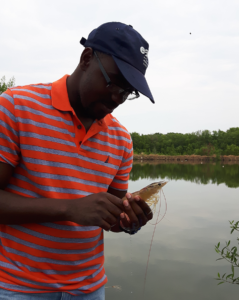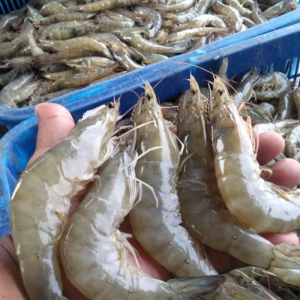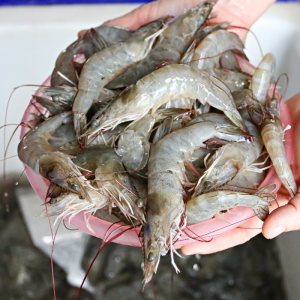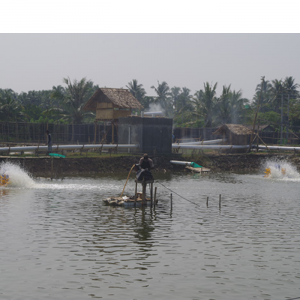
Innovation Award 2020 finalist: Simao Zacarias’ Shrimp Eyestalk Ablation Research
| Fri, 09 Oct 2020 - 10:12
The work of postdoctoral researcher Simao Zacarias on eyestalk ablation in shrimp hatcheries has been selected as one of three finalists for the Global Aquaculture Alliance’s annual Global Aquaculture Innovation Award.
Zacarias’ work focuses on a key animal welfare issue: the standard shrimp hatchery practice of unilateral eyestalk ablation to achieve higher egg production. Ablation has not only caught the attention of animal welfare advocates who are concerned about animal cruelty, but Zacarias notes that ablation of broodstock produces offspring that are more vulnerable to disease.
That’s crucial, given that perhaps the biggest challenge confronting the shrimp industry the past two decades has been disease. Based on evidence from his research in shrimp hatcheries in Honduras and Thailand, the University of Stirling researcher proved in laboratory testing that postlarvae and juveniles from non-ablated Pacific white shrimp broodstock showed higher survival rates when they were challenged with Acute Hepatopancreatic Necrosis Disease (AHPND, also known as Early Mortality Syndrome, or EMS) and White Spot Virus Disease (WSSV).
Also read: Transcriptomic Analysis of Pacific White Shrimp in Response to AHPND
Moreover, Zacarias believes that by providing high quality, nutritious feed to broodstock in their pre-maturation stage, shrimp farmers can achieve a similar egg production rate without resorting to eyestalk ablation.
“A dry and fresh feed composed of squid and polychaete stimulates broodstock to mature faster, leading to improved results in the breeding tanks,” he said. “Altering broodstock’s exposure to light, coupled with the high-quality feed, can enhance those results.”
Another means to achieving the same egg production rate is managing the sex ratio in breeding tanks and increasing the ratio of male-to-female shrimp from 1:1 to 1:2.
“We proved in my research that if you manage the sex ratio you’ll have similar productivity to that achieved with eyestalk ablation,” he noted. While this requires hatcheries to double the number of female shrimp in their breeding tanks, it would not necessarily double their costs, because eyestalk ablated females have a high mortality rate.
Also read: A Diet-Based Breakthrough in The Battle Against Early Mortality Syndrome in Shrimp
“If you don’t ablate you have a lower mortality rate of broodstock. We’re hoping to do an analysis in Thailand by the end of the year that will deliver the full economic impact of using non-ablated animals,” he said. “But from anecdotal information shared by hatchery managers I’ve learned that over time, with the next generation of non-ablated broodstock, you don’t need to increase that breeding ratio to achieve the same results. The shrimp will reproduce naturally when given a high-quality supplemental feed.”
Zacarias’ work is driven by the demand for better animal welfare practices in shrimp hatcheries.

“This innovation can be expected to become a key health strategy in shrimp farming going forward,” said Simao Zacarias.
“Retailers and buyers want the hatcheries to stop using eyestalk ablation,” he argued. “We have to use practices that improve welfare and reduce mortality. Firstly, ablating affects the well-being of the broodstock and leads to a higher mortality rate, which is bad for hatcheries. And secondly, the offspring of non-ablated broodstock are more robust animals with a higher survival rate when they are challenged by bacterial disease or White Spot Syndrome Virus. So even if not ablating results in increased production costs for hatcheries, the value of your end product potentially increases.”
If farmers knew they’d have more robust offspring from non-ablated broodstock, they would demand it, he argued: “It would reduce the need for chemicals and antibiotics to treat disease, and I’ll be showing at the GOAL conference that this has been proven under laboratory conditions.”
Also read: Marketplace to Industry, Governments: Solve Shrimp Diseases
Zacarias noted that not all shrimp genetic lines respond identically when ablation is stopped; some shrimp genetic lines will respond faster than others. Zacarias said hatchery managers might need to evaluate the variety of shrimp in their tanks, even within the same species.
Based on his research to date, his message to shrimp hatcheries and farmers is this: Stop eyestalk ablation and you give farmers an advantage by producing more robust postlarvae and juveniles that represent a more valuable and marketable product for the adopting hatchery, better survival and better finances.
“Consumers in Europe and America are demanding a product produced with high welfare, so if you cease eyestalk ablation you have access to a greater market share,” he said. “This innovation can be expected to become a key health strategy in shrimp farming going forward.”






















